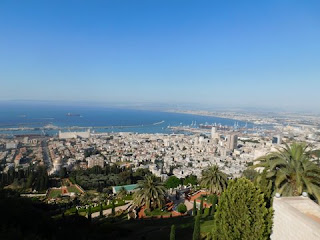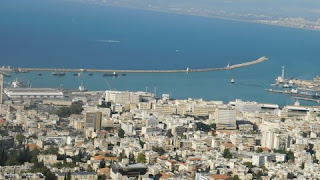Mount Carmel (Hebrew: הַר הַכַּרְמֶל, Har HaKarmel (lit. God's vineyard) is a coastal mountain range in northern Israel stretching from the Mediterranean Sea towards the southeast. The range is a UNESCO biosphere reserve and a number of towns are located there, most notably the city of Haifa, Israel's third largest city, located on the northern slope.
In mainstream Jewish, Christian thought, Elijah is indelibly associated with the mountain, and he is regarded as having sometimes resided in a grotto on the mountain.
Indeed, one name for Mount Carmel is جبل مار إلياس (Jabal Mar Elyas; Mount Saint Elias). In the Books of Kings, Elijah challenges 450 prophets of Baal to a contest at the altar on Mount Carmel to determine who was genuinely in control of the Kingdom of Israel; the narrative is set during the rule of Ahab.
Stella Maris Church Mount Carmel.

The Beautiful Dome of the Church
The Beautiful Port city of Haifa
Caesarea Maritima ("by the Sea") is located on the shore in the center of Israel, in the middle between Haifa and Tel-Aviv. It is the site of one of the most important cities in the Roman World, the Roman capital of the province of Judea at the time of Jesus.Initially, Caesarea was a Phoenician site in the Persian period (6 to 3rd C BC). The Phoenicians, the maritime merchants of the ancient world, used the natural bays and the nearby rivers in order to establish a port, one of many ports that they set up along the shore stretching from Tyre down to Gaza. The city flourished at the Greek period. Later, in the Roman period, King Herod created it into one of the largest cities in the Roman World, and called it after his patron, Augustus Caesar.
The Water Supply System: The Roman city got its water supply from the north by means of two aqueducts. The high level aqueduct reached the city as a double arcade carrying two channels. The later, western one is dated by inscriptions to the reign of Hadrian. The lower level aqueduct is a masonry tunnel, ca. 1.20m wide and 2.00m high, that got its water from an artificial lake constructed at the late 3rd century near the outlet of Nahal Tanninim to the Mediterranean. A Byzantine terra cotta pipeline reached the city from the north. A network of lead and terra cotta pipes running under the paved streets led the water to various public amenities: fountains, nymphaea, bath houses, latrines, and gardens. The palaces and rich mansions benefited from a running water supply as well. By the late Byzantine period, the water supply system deteriorated, and wells replaced the pipelines to some parts of the city.




























No comments:
Post a Comment